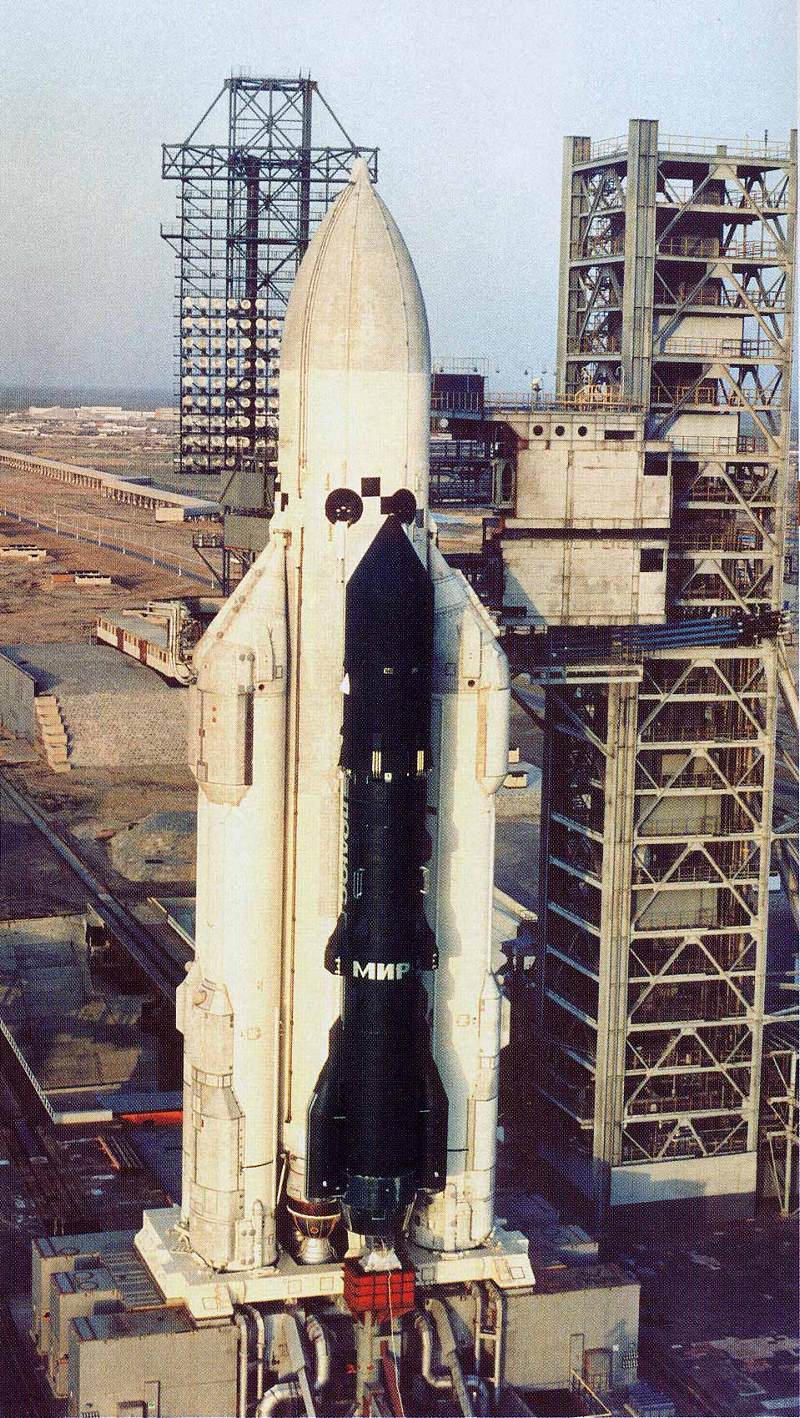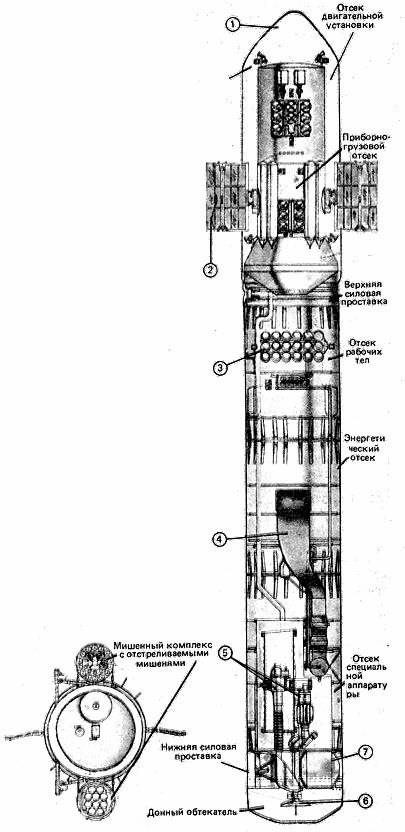|
Got a coupla' my own from the old obsolete weapons thread: Polyus  Remember how in the eighties, Reagan got all hot and bothered about space lasers and how they would give the United States tactical superiority over the Soviets IN SPACE? Remember how it was a colossal waste of money and literally nothing good came out of it? This was Polyus. It was the first payload the USSR sent up on their new Energia rocket booster, a massive engine stack that was designed for the never-used Buran Space Shuttle knock-off. It was a satellite that was designed with the sole purpose of countering the completely fictional threat of the Strategic Defense Initiative, and would've been the core for the proposed Mir-2 military space station.  Polyus was fitted with an inordinate amount of hardware, making it essentially the Star Wars that never was. Its payload was specifically designed to counter many of the threats SDI posed; it sported a radar-tracking cannon to defeat ASAT weapons, which also had an optical sighting system to track ASAT weapons without generating traceable signals. Hardware that was meant to test the effectiveness of barium clouds in dispersing particle weapons was also included, as was a module for the launching of space mines, most likely nuclear in nature (potentially used to neutralize MIRVs and their decoys). Also included in this delightful package was a laser and reflector for sensor blinding operations. Now, Gorbachev wasn't a total idiot and ordered the satellite to be launched unarmed, lest the USSR be seen as deliberately provoking the West, but were Polyus and Mir-2 ever to reach full operational capacity, it would've almost certainly changed the atmosphere of the cold war at the time, heating tensions between the USSR and US in a way that even Reagan's combative rhetoric couldn't hope to match. So, at this point you're probably asking yourself, "If the Soviets had a fully operational killsat, why haven't I heard about it ever before?" The Polyus payload was so enormous that it had to be loaded upside down on the Energia booster to counteract massive accelerative stress, placing the engines required for orbital insertion of the craft in the nose. This required the craft to yaw 180 degrees and then roll 90 degrees for orbital insertion burn. On May 15, 1987, the Polyus and its enormous booster roared of the launchpad at Baikonur and sped into the inky blackness of space. When the time came to perform the orbital insertion maneuver, the beweaponed satellite performed the 180 degree yaw, and then continued the turn to the full 360 degrees, rolled, and deorbited over the South Pacific. Whoops. In a way, the tale of Polyus and its sordid fate perfectly encapsulates the entirety of the Soviet Space Program. So it goes.
|
|
|
|
|

|
| # ¿ May 22, 2024 15:00 |
IJN Carrier Shinano Most folks are aware of the Yamato-class battleships built for the Imperial Japanese Navy. These monsters were the largest battleships ever laid down, armed with the largest guns ever put on a naval craft. Originally designed for what the IJN envisioned as a grand naval battle where top-tier battleships slugged it out on the high seas, they actually ended up being the collective gravestone for the age of the battleship. Both Yamato and Musashi were ignominiously sunk not in glorious naval combat, but by swarms of carrier-based airplanes who made short work of the two behemoths using air-dropped torpedoes and bombs. Perhaps somewhat ironically, there was a third Yamato hull that was converted to what, at the time, was the largest aircraft carrier ever built, but unfortunately it was terrible garbage. The Shinano was an enormous hulk of a carrier, dwarfing its contemporaries in the IJN. It had a flight deck capacity for 47 aircraft, though by her launch in November 1944, there likely would not have been enough experienced pilots left alive for that to have mattered. Having been converted from the third Yamato laid down, she was initially hilariously over-armored for a carrier, so the designers stripped the thickness down reasoning there was no reason for a carrier to ever enter front-line combat. This ended up being her downfall. After her commissioning in 1944, she was rushed into service as the IJN was worried about her being destroyed in her docks by US bombers. She was hurriedly launched on November 28, escorted by a measly 3 destroyers, and with the majority of her watertight doors not yet installed. About eight hours later, the American submarine Archer-Fish put four torpedoes into her and then retreated. Immediately, the Shinano began listing; though initially dismissed as little more than cosmetic damage thanks to her gratuitous armor, it soon became apparent that the mighty carrier had suffered catastrophic damage due to her shoddy construction. Within hours, the carrier had sunk beneath the waves, having been in service for less than a day. The crew of Archer-Fish had no idea what they had accomplished until back at base in Guam, having believed they had sunk just a 28,000 ton carrier. It wasn't until later that Naval intelligence was able to determine that they had actually sunk the 72,000 ton Shinano, making it the largest vessel in history to have been sunk by a submarine. The sub received the Presidential Unit Citation, and her captain, Joseph Enright, received the Naval Cross. Not a bad trade for four torpedoes. Interestingly, because of the immense secrecy behind the construction of the Shinano and its embarrassingly short service history, only two photographs of the ship exist: a high-altitude reconnaissance photograph taken by a B-29, and the photograph above, taken by a civilian tug during the initial sea trials.
|
|
|
|
Aleph Null posted:Didn't they decide that 100 mt wasn't worth it because an aerial blast (to maximize damage) would have lost a significant amount of its force to space due to the explosion being too freaking large? The device was too heavy to be delivered by rocket and had to be dropped by plane, and 50-ish megatons was already cutting it a bit close for comfort in terms of not vaporizing flightcrew.
|
|
|
|
Vlad the Retailer posted:The TP-82, AKA the Soviet Space Shotgun: You forgot to mention why the USSR felt the need to keep their Cosmonauts strapped in the first place: as all Russian space capsules were designed to land on... well, land, rather than water, there was a nonzero chance that a mishap in reentry could lead to a couple of shivering Cosmonauts fending off wolves in the wastes of Siberia. This wasn't a theoretical concern, by the way.
|
|
|
|
NTT posted:obviously its not 1:1 but something low mobility like that would make -mildly- more sense in a smaller country like france or germany It wouldn't, and it was cancelled for a reason (okay, several reasons). Sure, it was heavily armed and armored enough to theoretically take on an entire armored division and come out on top, but as soon as the Allies could pin its location down, they could just saturate the area with bombs dropped from B-17s flying well outside of the range of its paltry AA defenses. When the lynchpin of your armored forces is the size of a middling building and moves about half as fast, flattening it from the sky becomes extremely trivial.
|
|
|
|
|

|
| # ¿ May 22, 2024 15:00 |
spog posted:So, I guess my favourite system would be some time of large sign saying, 'Please don't shoot me, I am on your side' You joke, but the risk of accidental fratricide was one of the most important lessons carried over from Gulf War 1. 
|
|
|
|








